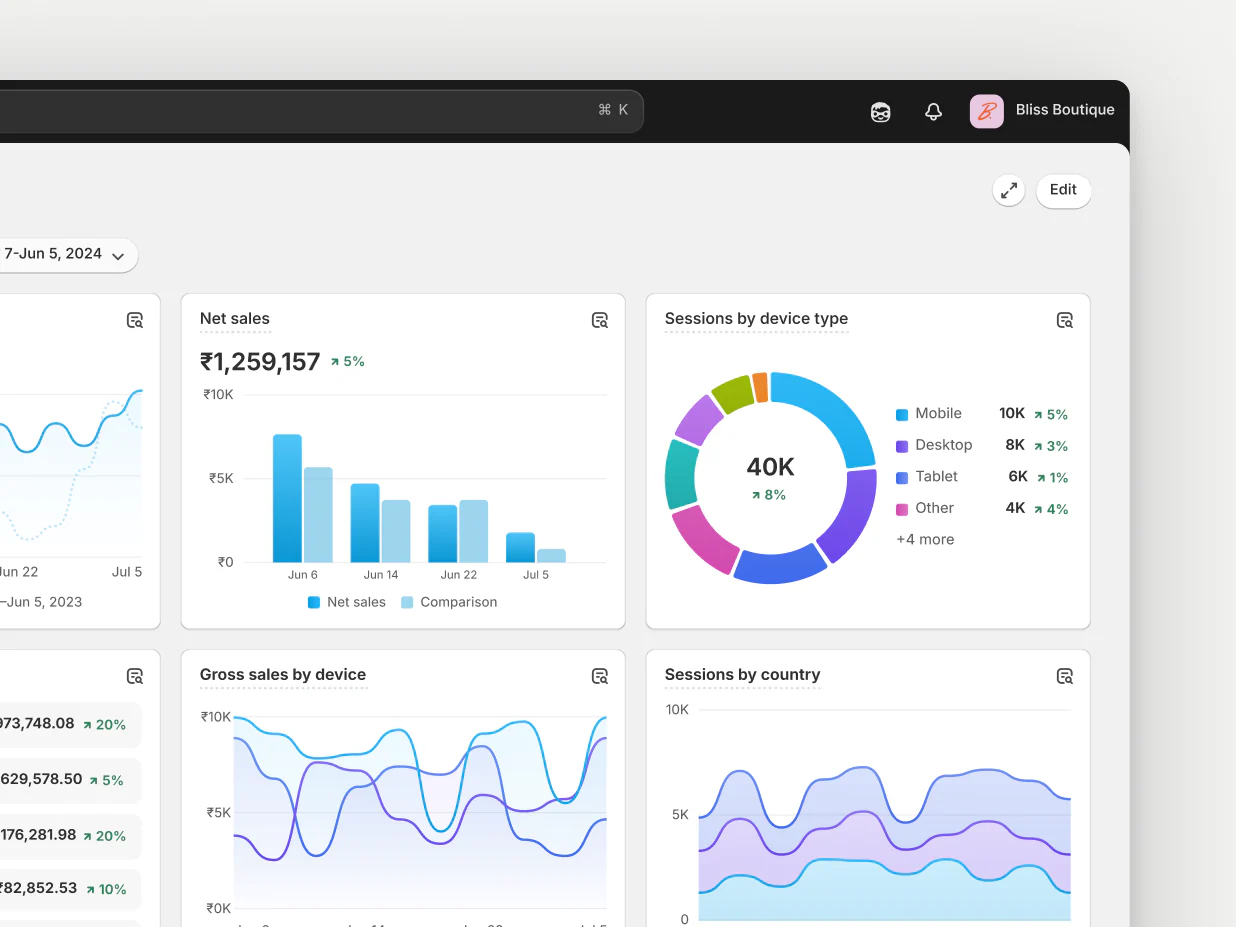
Why should data drive every Shopify decision? Data takes away guesswork from decisions. Believing in gut feeling or instinct is lauded in business decisions only when they bring results. Or else, you are taking a big risk.
But if you have data, you are hedging that risk. Because you might not be 100% accurate, but the chances of making the right decisions increase a lot.
However, having access to data isn’t enough. Shopify gives merchants access to a goldmine of analytics, yet many businesses still struggle. Why? Because they fail to identify which metrics truly drive revenue.
You could either spend your time tracking everything or ask the right questions to find which metrics matter and track them. For instance, campaigns that directly impact sales, retention, and customer lifetime value.
This is where Shopify analytics comes in. You can identify high-performing marketing channels, fine-tune your conversion tracking, and unlock the full potential of marketing analytics for e-commerce.
Why Shopify Analytics Matters?

The modern e-commerce environment is crowded and fast-paced. Brands that rely solely on intuition or surface-level metrics risk losing visibility into what’s actually generating revenue.
Mastering Shopify analytics is a must because -
- Accurate ROI measurement
Data-driven insights help you determine which campaigns deliver real returns.
- Smarter decision-making
From ad spend allocation to discount strategies, analytics reveal what’s working and what’s not.
- Customer understanding
You gain visibility into buyer behavior. For instance, how they arrive, browse, and convert.
Which Shopify Metrics Actually Drive Revenue?

While Shopify provides dozens of data points, not all are equally valuable. The key is focusing on metrics tied to revenue and retention, not vanity numbers. The core analytics you should focus on are -
1. Conversion Rate
Your conversion rate shows how effectively visitors turn into customers. It reflects the health of your site design, messaging, and user experience.
To improve it -
- Optimize landing pages with clear CTAs
- Simplify the checkout process
- Use conversion tracking tools to monitor drop-offs and completions
2. Average Order Value (AOV)
AOV helps you understand how much each customer spends per purchase. Small increases here can dramatically boost revenue without acquiring new customers.
3. Customer Acquisition Cost (CAC)
This measures how much you spend to acquire each customer. Comparing CAC to customer lifetime value (LTV) reveals whether your campaigns are profitable or not.
4. Returning Customer Rate
Retention is cheaper than acquisition. Tracking how often customers return and what brings them back is key to sustainable growth.
5. Revenue by Channel
Not all traffic sources are equal. Shopify analytics lets you see which channels, social media, paid ads, email, or organic search, drive the most profitable traffic. This insight informs smarter budget allocation.
6. Checkout Behavior Analysis
Shopify’s funnel reports show where customers abandon carts. Pair this with marketing analytics for e-commerce tools to identify friction points and recover lost sales through automation or retargeting.
Advanced Shopify Analytics Strategies
Shopify’s native reports are powerful enough. But if you want serious growth, you have to dig deeper.
1. Integrate Google Analytics and Meta Pixels
For detailed conversion tracking, integrate Google Analytics and Meta Pixel with Shopify. These tools give granular data on ad performance, user paths, and campaign attribution, helping you optimize for conversions, not just clicks.
2. Create Custom Reports
Use Shopify Plus or third-party analytics apps to create custom dashboards. Track campaign ROI, customer cohorts, and LTV trends across regions. This kind of marketing analytics for e-commerce ensures your data reflects actual business outcomes.
3. Segment Customers Intelligently
Shopify analytics allows you to group customers by purchase frequency, spending level, or geography. Personalized campaigns based on these segments consistently outperform one-size-fits-all messaging.
4. Track Attribution Accurately
Multi-channel attribution models reveal how different platforms contribute to a sale. For example, a user might click a Facebook ad but complete a purchase through email. Shopify’s data can show both.
5. Use Predictive Analytics for Growth
Modern tools, like Markopolo’s AI-driven analytics or Salesforce, go beyond historical data to predict future outcomes, forecasting sales, identifying churn risk, and suggesting next-best actions automatically.
How to Identify Revenue-Generating Campaigns?
The goal behind collecting data is to identify which campaigns are generating real revenue. For that, you can use this framework -
How To Turn Data Into Decisions?
Numbers mean nothing unless you know how to act on them. Use your Shopify analytics to make informed, revenue-driving decisions -
- If your conversion rate is low, then audit UX and improve load times.
- If CAC is high, shift budget to organic or referral campaigns.
- If retention is dropping, launch loyalty programs or personalized follow-ups.
Data is only powerful when paired with action. Shopify’s ecosystem gives you both the visibility and the tools to make smarter marketing moves every day.
Shopify analytics aren’t just dashboards; they’re your decision-making engine. By mastering conversion tracking and leveraging marketing analytics for e-commerce, you can identify what drives real revenue, cut wasted spend, and scale sustainably.
Follow for more updates on Shopify and e-commerce!
FAQs
1. What is Shopify analytics?
Shopify analytics is a built-in reporting system that provides insights into store performance, including sales trends, customer behavior, and marketing efficiency. It helps merchants make data-driven decisions that improve conversion rates and revenue.
2. Why is conversion tracking important for Shopify stores?
Conversion tracking shows how marketing efforts translate into sales. It identifies which channels and campaigns actually generate purchases, allowing brands to optimize ad spend and improve ROI.
3. What are the most important metrics in Shopify analytics?
Key metrics include conversion rate, average order value, returning customer rate, customer acquisition cost, and revenue by channel. These data points reveal how efficiently your campaigns turn visitors into buyers.
4. How can marketing analytics for e-commerce improve performance?
Marketing analytics for e-commerce helps brands measure the effectiveness of campaigns across platforms. It highlights high-performing channels, tracks customer journeys, and uncovers insights that guide better content and ad strategies.
5. What tools can enhance Shopify analytics?
Integrating Google Analytics, Meta Pixel, and AI-based tools like Markopolo provides deeper insights. These tools enable predictive modeling, multi-channel attribution, and automated reporting, making it easier to identify revenue-generating campaigns.
6. How often should I review my Shopify analytics?
Ideally, review key performance reports weekly and deep-dive monthly. Regular analysis ensures you spot trends early, respond to changes quickly, and continuously refine your strategy.







.png)
.jpg)
.png)



